FENE-P 流体在直线和曲线几何形状中单向流动的主曲线
IF 2.8
2区 工程技术
Q2 MECHANICS
引用次数: 0
摘要
我们证明,FENE-P(有限延伸非线性弹性,具有彼得林封闭性)流体的稳定单向剪切流的速度剖面,在经历典型的直线流(矩形通道或圆形管道中的压力驱动流)或曲线流(泰勒-库埃特或迪恩构型)时,服从通用主曲线,该曲线仅是 Wi/L 比值的函数,适用于固定的溶剂与溶液粘度参数 β。这里,Wi 是韦森伯格数,定义为哑铃弛豫时间与适当剪切速率的乘积,而 L 是聚合物的最大延伸与其平衡均方根端对端距离的比值。数据折叠和由此产生的速度剖面主曲线是对最近展示的稳定简单剪切流条件下 FENE-P 流体的聚合物粘度和第一法向应力系数主曲线的概括(Yamani 和 McKinley,2023 年)。对于压力驱动的通道流和管道流,我们推导出了 Wi/L≫1 高剪切速率条件下速度剖面的简单分析表达式,从而轻松阐明了聚合物的有限延伸性对速度剖面的影响。在 Wi/L ≫1 条件下,对于所考虑的所有流动,由于溶液总粘度不存在高剪切高原,溶剂为零的极限(β=0)被证明是奇异的,从而导致 β=0 和 β→0 时的速度曲线截然不同。本文章由计算机程序翻译,如有差异,请以英文原文为准。
Master curves for unidirectional flows of FENE-P fluids in rectilinear and curvilinear geometries
We demonstrate that velocity profiles for steady, unidirectional shear flows of the FENE-P (Finitely-Extensible Nonlinear Elastic, with Peterlin closure) fluid, undergoing canonical rectilinear (pressure-driven flow in a rectangular channel or a circular pipe) or curvilinear (in Taylor–Couette or Dean configurations) flows, obey universal master curves that are a function only of the ratio , for a fixed solvent to solution viscosity parameter . Here, is the Weissenberg number defined as the product of the dumbbell relaxation time and an appropriate shear rate, while is the ratio of the maximum extension of the polymer to its equilibrium root-mean-square end-to-end distance. The data collapse and the resulting master curves for the velocity profile is a generalization of the recent demonstration of master curves for polymer viscosity and first normal stress coefficient for a FENE-P fluid under steady simple shear flow (Yamani and McKinley, 2023). For pressure-driven channel and pipe flows, we derive simple analytical expressions for the velocity profiles, in the high shear-rate regime of , that readily elucidate the role of finite extensibility of the polymer on the velocity profiles. In the regime, for all the flows considered, the limit of zero solvent () is shown to be singular, owing to the absence of a high-shear plateau in the total solution viscosity, resulting in very different velocity profiles for and .
求助全文
通过发布文献求助,成功后即可免费获取论文全文。
去求助
来源期刊
CiteScore
5.00
自引率
19.40%
发文量
109
审稿时长
61 days
期刊介绍:
The Journal of Non-Newtonian Fluid Mechanics publishes research on flowing soft matter systems. Submissions in all areas of flowing complex fluids are welcomed, including polymer melts and solutions, suspensions, colloids, surfactant solutions, biological fluids, gels, liquid crystals and granular materials. Flow problems relevant to microfluidics, lab-on-a-chip, nanofluidics, biological flows, geophysical flows, industrial processes and other applications are of interest.
Subjects considered suitable for the journal include the following (not necessarily in order of importance):
Theoretical, computational and experimental studies of naturally or technologically relevant flow problems where the non-Newtonian nature of the fluid is important in determining the character of the flow. We seek in particular studies that lend mechanistic insight into flow behavior in complex fluids or highlight flow phenomena unique to complex fluids. Examples include
Instabilities, unsteady and turbulent or chaotic flow characteristics in non-Newtonian fluids,
Multiphase flows involving complex fluids,
Problems involving transport phenomena such as heat and mass transfer and mixing, to the extent that the non-Newtonian flow behavior is central to the transport phenomena,
Novel flow situations that suggest the need for further theoretical study,
Practical situations of flow that are in need of systematic theoretical and experimental research. Such issues and developments commonly arise, for example, in the polymer processing, petroleum, pharmaceutical, biomedical and consumer product industries.

 求助内容:
求助内容: 应助结果提醒方式:
应助结果提醒方式:


